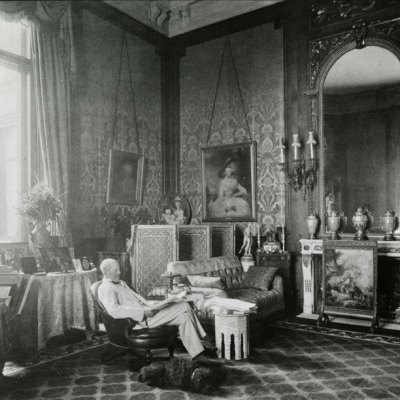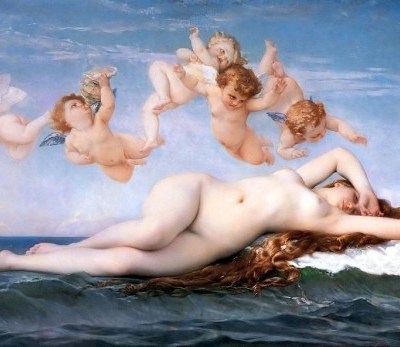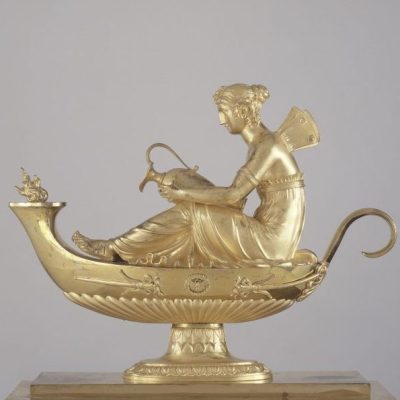Comprising three, beautifully illustrated tomes, analysing 120,000 works, and drawing on the expertise of more than 50 collaborators, Les Rothschild, une dynastie de mécènes en France is a landmark publication. These volumes do not simply join the bibliography of indispensable reference works on the Rothschilds, but are essential reading for anyone interested in the evolution of collecting practices in the modern era, from the digs at ancient Didyma through to spoliations by the Nazis or the gift of modernist paintings to the Pompidou. The Rothschilds’ intellectual passions encompassed so many fields (not just finance and the fine arts but philanthropy, archaeology, politics, physics, and the theatre) that this portrait of a family doubles up as a journey through many French milieux. The project’s editor Pauline Prévost-Marcilhacy summarises that ‘the patronage of the Rothschild family represents a European history of taste from the 19th to 21st centuries’.
Sections are dedicated to each of the major donors within the family. Prefaced by a vivid biographical portrait by Prévost-Marcilhacy, the ensuing chapters are taken by specialists who discuss the characteristics of the collections in depth. Only a roster of specialists could begin to tackle collections characterised as ‘immense, polymorphous and dispersed’. The project features eminent curators and scholars from around the world, including Ulrich Leben, Guillaume Séret, Françoise Barbé and Philippe Malgouyres; some of the chapters read like annotated commentaries through a genre of collecting, packed with information on manufacture, significance, and provenance. Such is the case with Michèle Bimbenet-Privat and Alexis Kugel’s survey of the German silverware and historic jewels amassed by Salomon de Rothschild, or the chapters accorded to Edmond de Rothschild’s peerless ensemble of graphic works donated to the Louvre in 1934.
The project is held together by Prévost-Marcilhacy’s examination of the links between different types of object, different members of the family, and the different contexts of collecting. Unlike the British Rothschilds, whose impact on public institutions hinges on the figure of Ferdinand and the Waddesdon bequest, the French branch of the family constituted a multigenerational collective. There was no shared goût Rothschild, but rather an awareness of how individual preferences fitted within the dynastic profile. Motivated by a strong sense of family memory and civic responsibility, individual Rothschilds sought to uphold traditions of artistic largesse. Henri de Rothschild described his donations in 1933 and 1947 as a ‘social duty’, and saw himself as the mere dépositaire of his treasures. While he specialised in rare books and autographs, he also continued his grandmother’s devotion to Chardin. The analysis of outlying and overlooked personalities is especially refreshing. There are revelatory accounts of Arthur and his interest in ‘popular’ pastimes like philately, or the pipes and matchboxes bequeathed by Alice to the town of Grasse.
The role of the Rothschild women was certainly remarkable. A distinguished artist in her own right, Charlotte de Rothschild felt liberated after her husband Nathaniel’s death to pursue her own preferences. This included 18th-century France and Italy, and the Isaac Strauss collection of Judaica that she gifted to Cluny in 1890 (the first such donation made to a French museum). Just as Thérèse preserved James Édouard’s library as an ‘inviolable temple’, so her sister, the widowed Adèle, guarded her husband Salomon’s decorative arts treasures for 58 years on the rue Berryer. The blurring of domestic and museum spaces mirrored the 1933 donation of her Cap-Ferrat residence to the Institut de France by Béatrice Ephrussi de Rothschild. More a ‘décoratrice’ than a ‘collectionneuse’, Béatrice charged the architects to impart a domestic feel to a villa which she had only episodically inhabited.
Three themes seem especially pertinent. The first concerns the interaction between the Rothschilds and a wider culture of expertise. The preferences of the individual collector were powerfully informed by counsel from curators and dealers, including Gustave Lafenestre (Charlotte’s guide through Italian Primitives), André Blum (Edmond’s keeper of works on paper), or the unscrupulous Frédéric Spitzer who advised Adolphe (‘Dolly’). Second, the Rothschilds’ engagement with the art market was on a scale hitherto unsuspected. Edmond made many purchases as a form of philanthropy. Prompted by the Belgian dealer Léon Gauchez (working under the alias of Paul Léroi), Alphonse embraced an agenda to decentralise art. Around 250 provincial museums – one half of all museums created in France before 1914 – received a donation from Alphonse, amounting to 2,000 works in total.
Thirdly, this investment in the moralised visual style of the Third Republic indicates the extent to which the family internalised the regime’s values and commitment to art for the people. Just as collecting transitioned from being a private luxury to a public benefit, the Rothschilds collected and exhibited global art as a way to valorise the national heritage. The installation of the Boscoreale discoveries in the Louvre, paid for by Edmond, was an explicit riposte to rival museums in Berlin. In the enormity and diversity of their collections, this Jewish family did more than any one else to constitute the patrimony of a nation in which their citizenship was venomously contested. In one sense, their collecting functioned as a symptom and strategy of national assimilation; however, the Rothschilds did not so much buy into French civilisation, as constitute it through their munificence, making it publicly accessible and immortalising their family’s role in its conservation. This brilliantly researched collaborative venture highlights the interplay between individuals, institutions, and those exquisite objects that articulated the (longed-for) grandeur of France.
Les Rothschild, une dynastie de mécènes en France, 1873–2016, edited by Pauline Prévost-Marcilhacy, is published by Éditions du Louvre/BNF/Somogy éditions d’Art (€290)



